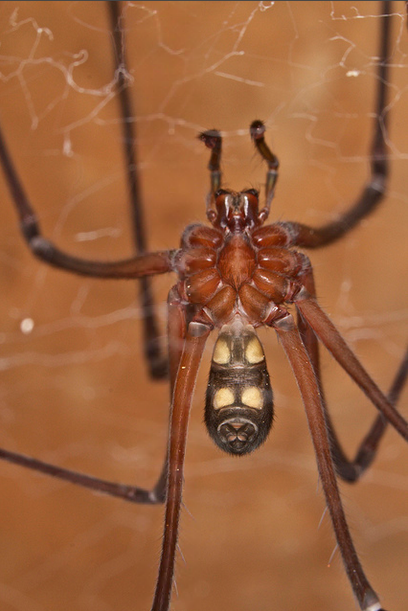Reproduction
The Tasmanian cave spider (Hickmania troglodytes) has a unique
reproductive lifestyle that begins with courting the female. The
cycle typically begins in late winter up until early spring when the
weather is a little more chilly (Austrailian Museum. 2014). This is the most common time to
sexually interact due to the life cycle of the offspring ( we will
talk more aout that later). They will have a better chance of
survival if they hatch during early to late fall.
The male spider will begin a ritual where they use leg gestures
to entice the female. The goal here is basically to just pull out
all the stops and woo the female. It may appear as a dance but the
spider is actually trying to make distinct patterns against the web
that will appeal to female spiders and make the male spider more
sexually attractive. By plucking his leg ,
and leg hairs against the web, it can send strong vibrations across
the web to the female who will take notice in his gestures (Doran
et
al. 1999). Once she
becomes interested, she will begin to rub up against his legs,
stroking his leg hair. These leg movements are not only used to
communicate to the female but also to protect the male from other
males looking for attention (Doran et al. 1999). Attracting a female can take over 5
hours depending on the attraction level. So basically, if the female
isn't feeling like the male is good enough, he better be prepared
for five long hours of web plucking. Eventually a female takes
notice in this unique ritual and will advance on to the next stage
with the male: sex. The male will then mount the female and use his
specially rounded leg to anchor the female to his body. With this
leg he holds her head and pulls apart her mandibles so the two can
proceed in a safe manner. The sexual stage can sometimes take over 5
hours (Doran et al.1999). Talk about exhausting.
,
and leg hairs against the web, it can send strong vibrations across
the web to the female who will take notice in his gestures (Doran
et
al. 1999). Once she
becomes interested, she will begin to rub up against his legs,
stroking his leg hair. These leg movements are not only used to
communicate to the female but also to protect the male from other
males looking for attention (Doran et al. 1999). Attracting a female can take over 5
hours depending on the attraction level. So basically, if the female
isn't feeling like the male is good enough, he better be prepared
for five long hours of web plucking. Eventually a female takes
notice in this unique ritual and will advance on to the next stage
with the male: sex. The male will then mount the female and use his
specially rounded leg to anchor the female to his body. With this
leg he holds her head and pulls apart her mandibles so the two can
proceed in a safe manner. The sexual stage can sometimes take over 5
hours (Doran et al.1999). Talk about exhausting.
If the pair successfully procreates the female will now lay the
eggs in a sac that she created beforehand. This intricate egg sac is
lined in a thick layer of elaborately threaded silk. The silk wall
is extremely thick to allow for protection for the offspring.
Because the walls are so intricately weaved, it’s much harder for
predators to break the sac open and attack the offspring
(Austrailian Museum. 2014) . Using silk as a lining furthermore
keeps away any fungi or mildew that could potentially harm the brood
(Doran et al. 1999). Also, the sac can adjust the temperature to fit
the needs of the baby spiders in order to provide the best outcome
of offspring (Austrailian Museum. 2014). Even though many offspring
will be in this sac, it is actually only 2-4 cm long and is more of
a pear shape than the typical ball shape (Austrailian Museum. 2014).
The egg sac sits in an area guarded by the mother. She will sit
nearby, in a hidden area, to watch for possible predators and will
attack any that come near her sac. She will also use camouflage such
as leaves and moss to hide the sac in hopes that predators will not
notice it under average seeming
elements (Doran et al. 1999). Eventually the baby spiders will emerge after nearly eight
to ten long months. This period is far longer than the average
arachnid whose offspring only need four to eight weeks. It’s been
noted that Tasmanian cave spiders typically live longer lives than
the average spider (Doran et al. 1999). Once the young spiders escape from the sac they
head towards the back of the cave, much further than the adults, and
reside there until it is their turn to take care of the cave. Thus,
the circle of life is continued.
Continue to the interactions page!
Return to homepage